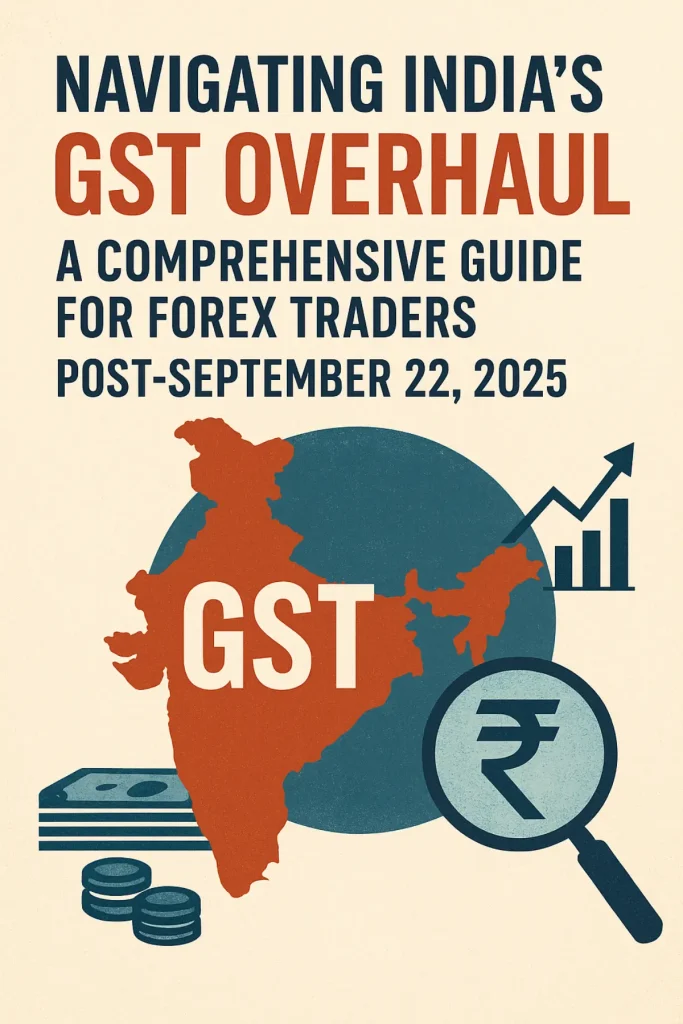
On Sept 22, 2025, India is changing its GST system. Instead of multiple tax rates from 5% to 28%, there will only be two: 5% and 18%. This should make taxes easier, encourage people to pay them, and help the Indian economy. This change will also affect the forex market. Traders should know how the new GST impacts the Indian Rupee (INR). This article will explain the GST changes and what they mean for the Indian forex market.
What is GST?
Goods and Services Tax (GST) is an indirect tax that India uses now instead of a bunch of other taxes like excise duty, VAT, and service tax. It makes taxes simpler. GST is a value-added tax that’s charged at each step when something is made and sold. The goal is to make one big national market, make doing business easier, and get rid of tax on tax. GST applies to both goods and services. If businesses make enough money, they need to sign up and follow the GST rules.
The New GST Structure
Since it started in 2017, India’s GST system has seen some updates. But on September 22, 2025, the biggest change will happen: a two-level GST setup.
5% Level:
This 5% level is for important goods and services. By taxing everyday things at a lower rate, the government wants to keep prices down for people. Basic stuff like packaged food, medicine, and other daily needs will be in this group.
18% Level:
Most goods and services will be under the 18% level, like electronics, cars, and building supplies. Though it’s more than the 5% rate, it’s seen as a middle-ground rate for many products and services that people use.
Fancy and Harmful Stuff:
Things like expensive cars, tobacco, and alcohol will have a special 40% tax rate. Because these items aren’t seen as essential or are bad for you, they’ll still be taxed heavily to cut down on their use and make money for the government.
GST Slabs Comparison (Post-September 2025)
| Category | 5% Slab | 18% Slab | 40% Slab |
| Essential Goods | Packaged food, life-saving medicines | Basic household appliances | |
| Consumer Electronics | Mobile phones, televisions, and laptops | ||
| Automobiles | Small cars, motorcycles | High-end cars | |
| Luxury Items | High-end watches, Luxury vehicles | ||
| Healthcare | Medicines, medicinal devices | ||
| Luxury and sin goods | Tobacco, alcohol, and casinos |
Why is GST Being Overhauled?
The major reasons behind the GST overhaul are:
- Tax Made Easy: The old four-tier setup was a headache, especially for small businesses. Now, with the two-slab system, taxes will be simpler, and businesses can more easily follow the GST rules.
- More Spending: With lower taxes on must-have goods, shoppers will see cheaper prices, which could get people buying more.
- Growing the Economy: This change aims to help the economy grow, especially with all the uncertainty around the world. By cutting taxes on everyday stuff, the government wants to get people spending, which should then help boost production and the economy.
- Keeping Money Coming in: The special tax rates on fancy items will help the government keep a steady income without hitting the basic stuff too hard. This way, the government gets what it needs while keeping the tax system fair.
Impact of the GST Reform on the Indian Forex Market
The new GST system, while beneficial for domestic markets, will have a ripple effect on India’s forex market. Here’s how the forex market will be impacted:
1. How Currency Value and Trade Balance Work
- What it Means for the Rupee: GST changes could really shake up the Indian Rupee (INR). Since essentials will cost less, people might start buying more stuff. If that happens, India could import more. This could cause India’s trade to drop, since we’d be buying more goods from other countries than we’re selling. This trade drop could make the INR weaker compared to currencies like the U.S. dollar.
- Foreign Exchange Holdings: If the INR loses value, it can also mess with India’s foreign exchange reserves. To keep things stable, the Reserve Bank of India (RBI) might step in by changing interest rates or doing other things in the market.
2. Inflation Problems
The GST changes should lower inflation by about 1.1%, but more demand for stuff could raise prices, especially if suppliers can’t keep up. Higher demand might also increase the price of imported goods, which could change inflation rates. Forex traders should watch inflation numbers closely because they really matter for currency stability.
3. Foreign Investment
Because GST is now simpler, India will probably be more appealing to foreign investors. With easier taxes and potentially lower business costs, foreign direct investment (FDI) might go up. This cash influx could help the INR because foreign money is flowing into the Indian economy. However, things happening around the world, like what the US Federal Reserve does or political stuff, could still affect these flows.
4. Global Trade and Political Risks
India’s growing trade means it’s open to global trade changes. Any problems in global trade or political issues could make the forex market more unstable. Forex traders should expect changes because of these kinds of political risks.
Guidance for Forex Traders in the Post-GST Scenario
If you’re trading foreign currency, it’s important to understand how India’s GST changes things. Here’s some easy advice for trading:
1. Watch the Numbers
Keep up with India’s economy. Look at things like how much India is trading, how fast prices are rising(inflation), and where foreign investments are going. These numbers can tell you where the Indian Rupee (INR) might be heading after the GST changes.
2. Mix Up Your Currencies
The INR might drop, so don’t put all your eggs in one basket. Trade other pairs like USD/INR, EUR/INR, or GBP/INR to spread out your risk. You may want to trade things like gold, which usually stays steady when currencies are shaky.
3. Control Your Risk
Handling risk is super important after the GST changes. Use things like stop-loss orders and smart position sizing to guard against sudden market moves. Knowing what’s happening in India and around the world can help you lower possible risks.
4. Listen to the Central Bank
The Reserve Bank of India (RBI) is key to keeping the economy steady. Pay attention to any changes they make to interest rates or how they manage money because of the GST changes. These moves can change the value of the INR.
Conclusion
India’s GST change, starting September 22, 2025, is a big deal for how the country taxes things. These new GST rates are supposed to make taxes easier to understand and get people to buy more stuff. But they could also really shake things up in the Indian money exchange market. Traders need to pay close attention, keep an eye on important economic signs, and tweak their plans as needed.If you’re a trader wanting to make the most of these changing times, check out TFX Ltd. They have a simple and trustworthy trading platform. You don’t have to pay any brokerage fees, plus they offer 500x Leverage and let you withdraw your money anytime. TFX wants to make sure traders can handle market changes without worry. Go to tfxltd.com to see their cool tools and learning materials made for traders.



